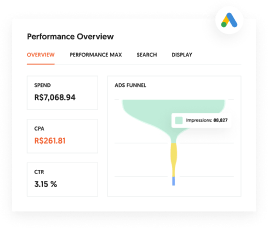
Have you defined the distribution channels that your company intends to use?
If not, it’s time.
In short, distribution channels determine the path goods take from the manufacturer to the final consumer.
Thus, they have a direct impact on sales.
There are many types, formats, and levels of distribution channels.
The first step is to understand each of them.
To help you with this task, this article details the many aspects of distribution channels, including:
- What distribution channels are
- The three types of distribution channels
- Three distribution methods
- Distribution levels
- The main intermediaries
- How to define them
Before we get too far into it, let’s start with an explanation.
What Are Distribution Channels?
Distribution channels are the paths products take from their initial manufacturing stage to selling them to consumers. For instance, if you go to a retail store to buy a product, the distribution channel typically includes the manufacturer, a distributor, and the retailer.
Let’s use the laptop computer as an example. The distribution channel for a laptop can include the manufacturer, who produces the laptop, a distributor who warehouses and ships the laptops to retail stores, and retail stores who sell the laptops to the final customer.
In the case of online selling, the distribution channel might have some variations.
The Three Types of Distribution Channels
As detailed below, there are three ways to ensure a product gets to the final consumer.
1. Direct Distribution Channels
With this model, the company is fully responsible for delivering products to consumers through direct channels. Goods only go through intermediaries after reaching their final destination. This gives manufacturers total control over the distribution channel.
An excellent example of a use case is people who do catalog sales. Since the manufacturer alone is responsible for delivering products, this channel generally makes it impossible to have a huge volume of customers.
At the same time, offering lower prices is possible since the company does not have to pay commissions to intermediaries.
2. Indirect Distribution Channels
With indirect channels, intermediaries deliver products rather than sellers.
Who are these intermediaries? They could be wholesalers, retailers, distributors, or brokers.
In this case, manufacturers do not have total control over distribution channels.
The benefit is that this makes it possible to sell larger volumes and sell to a range of customers. However, products have higher prices due to the commissions paid to intermediaries.
3. Hybrid Distribution Channels
Hybrid channels are a mix of direct and indirect channels.
In this model, the manufacturer partners with intermediaries in this model but still controls customer contact.
One example is brands promoting products online but not delivering them directly to customers.
Instead, they nominate authorized distributors.
Three Methods for Distribution Channels
You can use a few different distribution channels to get your product into customers’ hands. They are:
- exclusive distribution
- selective distribution
- intensive distribution
Basically, these channels determine who can sell and distribute your products as shown in the visual from Waalaxy below:
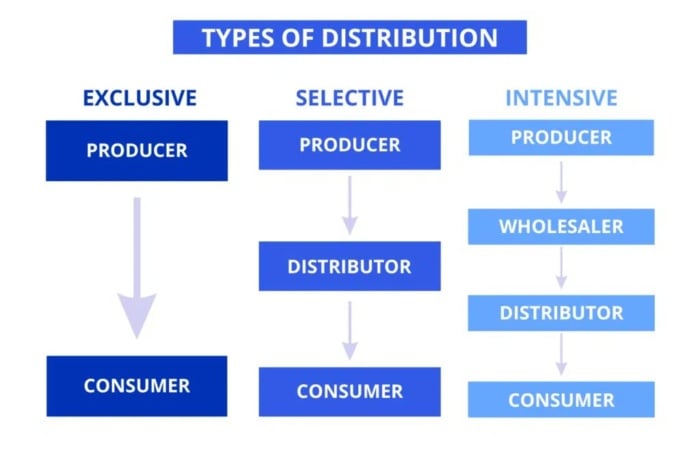
Let’s look at them in more detail.
1. Exclusive Distribution
With exclusive distribution, intermediaries take the company’s products to specific sales outlets.
This means that only exclusive retail outlets can sell the items to consumers.
Depending on the quality of the product, this is an excellent strategy for manufacturers and the retail outlets or chain stores selected.
2. Selective Distribution
With selective distribution, the company allows sales to a specific group of intermediaries who sell the items on to final customers.
An important factor in how successful this strategy will be is the intermediaries’ reputation since they directly impact the company’s performance.
In this case, the intermediary becomes the real consumer consultant, answering questions and recommending appropriate products for their needs.
3. Intensive Distribution
In intensive distribution, the manufacturer places a product in as many sales outlets as possible.
This method involves the manufacturers, sales teams, and commercial representatives; They distribute products to sales outlets.
Manufacturers of low-cost products generally use this distribution method with a high frequency of consumption.
Distribution Channel Levels
Distribution channels can also operate on different levels.
Their levels represent the distance between the manufacturer and the final consumer.
Level 0 Distribution Channel
The manufacturer and the client have a close and direct relationship at this level.
For the company, the relationship costs with the consumer are higher.
Level 1 Distribution Channel
In level 1, the manufacturer sells the products to the distributor, who might sell them to consumers via retailers or wholesalers.
The distributor keeps some of the rights to the product but not all.
The distributor is also responsible for sales and transportation costs to sales outlets.
Level 2 Distribution Channel
Level 2 is similar to Level 1.
The difference is that the distributor delivers products only to retailers, who sell them to consumers.
Level 3 Distribution Channel
Level 3 channels are a traditional distribution model.
The product’s journey from the manufacturer involves the distributor, retailer, and customer.
The costs relative to sales and marketing are divided between the parties.
The advantage of this model is that it’s possible to reach more consumers.
On the other hand, products have a higher price because of the parties’ operational costs.
The Nine Main Intermediaries in Distribution Channels
Now you know all about the operation details, it’s time to detail the main intermediaries who take products to consumers.
1. Retailers
A retailer is an intermediary between the consumer and a manufacturer.
There are a lot of examples out there, but some of the most common are pharmacies, supermarkets, bars, and restaurants. In these situations, the business has full sales rights.
The bulk of the time, you’re going to see higher product prices at a retailer. Generally, product prices are higher in retailers. Take a look at the different types in this example from Chegg:
2. Wholesalers
Wholesalers are intermediaries that buy products in bulk ready to sell on to retail stores. As the products are sold as bulk, they’re sold at a discount.
The wholesaler also stores products, transports them to retailers, and offer credit accounts for retailers.
Note that you’re generally not going to see these entities selling a smaller quantity to the end consumer, but you might see exceptions. One prominent one is supermarkets like Costco that sell in the wholesale model.
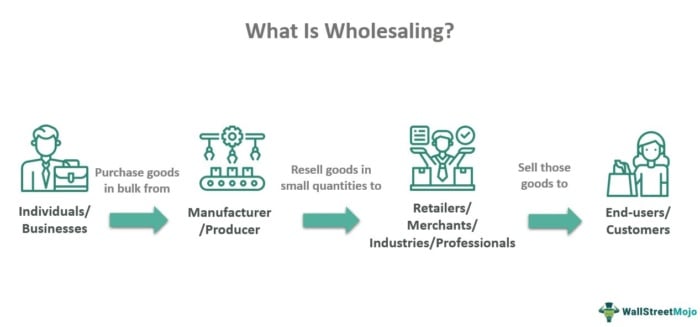
Prices are lower because sales involve large quantities.
3. Distributors
Distributors ensure products get from the manufacturers to the end consumers. They might also provide logistical support, financing, and market research.
4. Agents
Agents are intermediaries that connect producers with the end customer. They help the producers sell products to consumers and earn a commission for their sales.
They also transfer the title of goods/or services during the distribution phase.
5. Brokers
As opposed to agents, brokers have short-term relationships with the company. Brokers, like real estate agents and insurance brokers, for example, also receive a commission.
6. The Internet
To those who sell tech and software, the Internet is the distribution channel’s intermediary.
The consumer only has to download the material to access it.
E-commerce companies also use the Internet as a distribution intermediary.
7. Sales Teams
Companies often have their own internal and external sales teams. Usually, these teams will work with manufacturers and distributors.
It’s the sales team job to find prospects, create leads, and close deals.
There is also the possibility of creating more than one team to sell to various segments and audiences if the company has a wide range of products.
8. Resellers
Resellers purchase from manufacturers or distributors. They then sell them on to consumers at a mark up. to sell on to consumers.
9. Catalog
Catalog sales involves a sales person selling products direct from a printed publication. Think Avon or Natura. Salespeople in this model also usually earn a commission for their sales.
Reverse Distribution Channel
Those are the types and methods available for products to reach customers. However, what happens when consumers need to return items to manufacturers?
Consumers must rely on reverse distribution if they receive defective products or need to return clothes or shoes they bought online that don’t fit.
In this case, the consumer is responsible for returning the items and needs to find information from the manufacturer about how to do this. Usually, consumers find information about returns on the site for the product.
How Do Distribution Channels Impact Your Marketing?
The distribution process you choose can have a significant impact on your marketing. For example, if there are shipping delays or supply chain disruptions, it affects product availability. This can result in a significant impact on sales and marketing activities. Even if the marketing campaign is well-executed, if the product is unavailable to consumers, the campaign may not be as successful as intended.
The impact of events like COVID-19 is the most recent example of how distribution channels and marketing depend on easy over.
The pandemic led to a significant impact on both distribution and marketing channels. For instance, goods were restricted across borders, meaning shipping delays. This meant many businesses had to take a second look at their distribution channels and look at new ways of marketing their products.
However, brands found ways to overcome such challenges.
For example, during COVID, athleisure brand Lululemon transformed its online marketing channels into an engagement platform providing free workouts to build a global community and highlight their brand via its YouTube channel:

Lululemon also increased the price of its best-selling lines and introduced flexible payments.
The cost of distribution channels also impacts your marketing. Methods like indirect or direct can cost a significant amount upfront and may mean you must sell your products at a higher price tag. This can reduce product demand, making it challenging to impact new channels and drive growth.
Alternatively, you could use multi-channel marketing. Combining multiple distribution channels with multi-channel marketing allows companies to appeal to a broader range of customers and cater to their unique needs.
For example, a company may sell products through its website, in-store, and social media. Multi-channel marketing tactics like targeted advertisements and personalized messaging can drive customers to these various distribution channels based on their preferences and behaviors.
To narrow down your brand’s best marketing/distribution channels, ask yourself two questions.
1. Who are your customers?
2. Where do they hang out?
If you’re new to business and want help answering this, draw up your ideal customer persona like this:
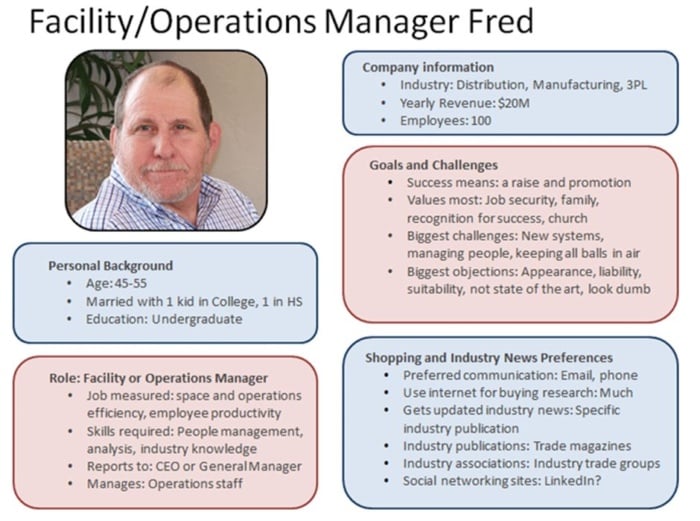
That’s how your marketing channels tie in with your distribution channels. Now let’s move on to selecting distribution methods.
How to Select Distribution Channels for Your Product
In this section, we’ll take a closer look at the steps involved in selecting distribution channels for your product.
1. Benchmarking
First, you must look at your competitors to find the best practices they’ve adopted.
This kind of mapping is known as benchmarking. This process involves comparing your organization’s products, services, or processes to those of your competitors or other relevant organizations in your industry.
The idea is to figure out the distribution strategies your competitors use and the areas they excel and do the same. By analyzing competitors, you can also identify any room for improvement in your business and enhance your company’s performance
2. Project Review
You’ve mapped out best practices in the market and identified solutions that could work for your business.
Great.
The next step is to review the project/channel you created.
Check if there are errors and how you can optimize the processes you’ve adopted and adapt the project to the needs and characteristics of the type of sales you make.
One way to analyze a distribution channel is to examine customer behavior data, sales volume, and feedback from sales teams. For example, understanding which channels have the highest conversion rates can help you discover areas for improvement in the distribution process.
3. Costs and Benefits
When we talk about distribution channels, one crucial factor is their cost.
Always look for the best cost-benefit ratio.
Cost-benefit analysis is a way of evaluating the pros and cons of a decision by comparing the costs involved with the potential benefits. To calculate cost-benefit, you subtract a project’s or decision’s total cost from the total benefits or expected returns.
There needs to be more than a vague idea of the costs to do this. You must record all costs and analyze if the benefits of the channel you selected are worth it.
For example, imagine a business is considering implementing a new software system to increase productivity. First, they would need to estimate the cost of the software and any associated costs, such as training and IT support.
Let’s say the total cost is $50,000. Next, it would need to calculate the potential benefits. For example, if the new software increases productivity by 10 percent and the average employee earns $50,000 per year, the potential benefit would be an additional $5000 per employee yearly.
If the business has 50 employees, the total annual benefit would be $250,000. That would make the software a worthwhile investment.
4. Company’s Daily Routine
Another relevant factor is the business routine.
What are the projects, processes, and activities in your business?
You must ensure your chosen distribution channel aligns with the day-to-day working of your company.
Otherwise, logistics problems might result in product delays and potentially damage your customer relationship. For instance, if your chosen distribution channel relies on a fast turnaround time for order fulfillment, ensure that your teams and processes are set up to accommodate this schedule.
Overall, aligning your chosen distribution channel with your daily routine and ensuring that any logistical challenges are anticipated and addressed can help your business meet its goals and maintain positive customer relationships.
5. Market Potential
Before selecting a channel, you should also consider the market potential of intermediaries.
After all, unless you choose to use direct channels, they will also be responsible for sales results.
Market participation, reputation, and performance are the three most important elements to consider.
First, look at market participation. This refers to intermediaries who are active and engaged in the market. For example, suppose you are considering a distribution channel through a retail partner. In that case, it is necessary to assess their presence in the market, including factors such as the number of stores they have and their geographic reach.
Then consider the potential intermediary’s reputation. By selecting intermediaries with a good reputation and strong brand recognition, you can more easily build trust with your target audience. Additionally, a reputable intermediary may promote your brand and products more effectively, which can help drive sales.
Finally, look at performance. This can include factors such as track record of success, marketing capabilities, and sales expertise. Find intermediaries with a proven track record of success who can demonstrate their ability to market and sell products effectively.
6. Logistics
When considering distribution channels for your business, think about how it’ll work logistically.
Logistics refers to the process of managing the movement of goods from the point of origin to the point of consumption, and it encompasses a wide range of activities, including transportation, storage, and delivery.
Consider logistical questions like:
- How will the distributors/my company transport the products?
- Is there security for when the products are in transit and/or where they are stored?
- Where will my business store the goods? This may involve leasing or purchasing a warehouse or working with a partner with storage capabilities.
- What is the average delivery time? Can the distribution channels you’re looking at deliver efficiently and cost-effectively?
Analyzing all stages of logistics is crucial to avoid problems taking goods to sales outlets and keeping the end customer satisfied.
7. Location
Finally, consider the location of intermediaries, whether they are resellers, retailers, wholesalers, or distributors.
After all, your product must be sold in the region where your target audience is, especially if you supply a specific market niche.
By finding intermediaries tailored to your product niche and with an established regional presence, you are in a better position to reach your target market and achieve your sales goals.
Managing Distribution Channels
How should you manage your company’s distribution channels? This is usually the responsibility of marketing departments.
It’s essential to monitor key performance indicators (KPIs) to do it.
Carry out regular assessments of reports with metrics and indicators related to distribution processes.
Monitor sales indicators, for example, analyzing the performance of each channel the company uses.
Also, conduct satisfaction surveys with consumers, especially when customers express dissatisfaction with the selection and availability of goods or when sales volume is below expectations.
Examples of Distribution Channels
Before concluding this piece, let’s get to know two examples from great companies.
Coca-Cola’s Distribution Channels
The world-famous drinks company boasts the ‘world’s largest beverage distribution system”. It looks like this:
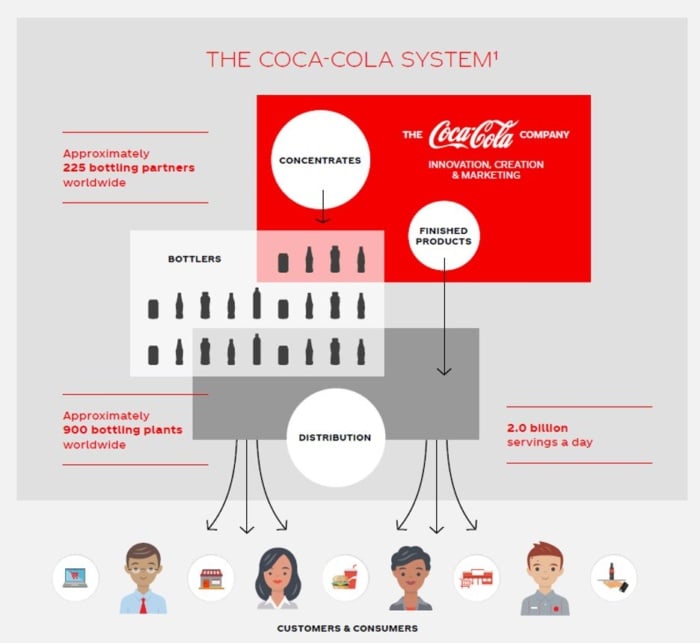
Or this:
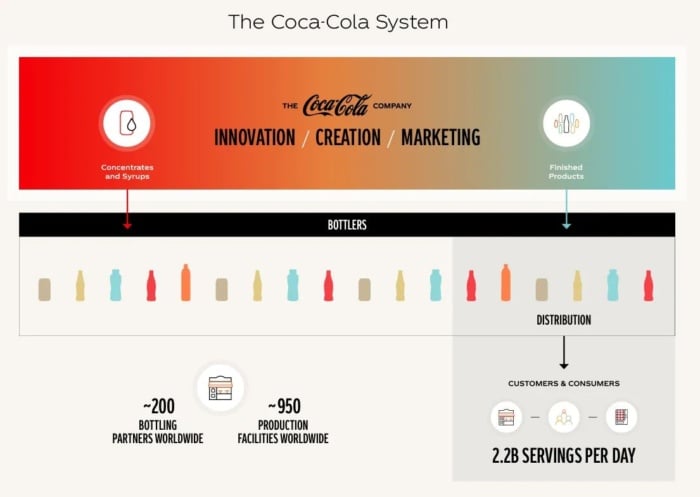
The Coca-Cola Company sells products in over 200 countries and territories. It works with independent bottling partners and consolidated bottling and distribution operations.
The products then get packaged and merchandised, and finished branded products get distributed to customers (grocery stores, street vendors, movie theaters, amusement parks, etc.). Vending partners sell Coca-Cola products to regular consumers globally. This process enables the sale of an incredible 2.2 billion servings of Coca-Cola daily.
Natura’s Distribution Channels
Cosmetics brand Natura markets its products under various brands, including The Body Shop and Avon. Publishing catalogs used to be its primary distribution method, but it’s since expanded its distribution channels considerably.
It uses a combination of distribution channels, including business-to-business, e-commerce, and franchises.
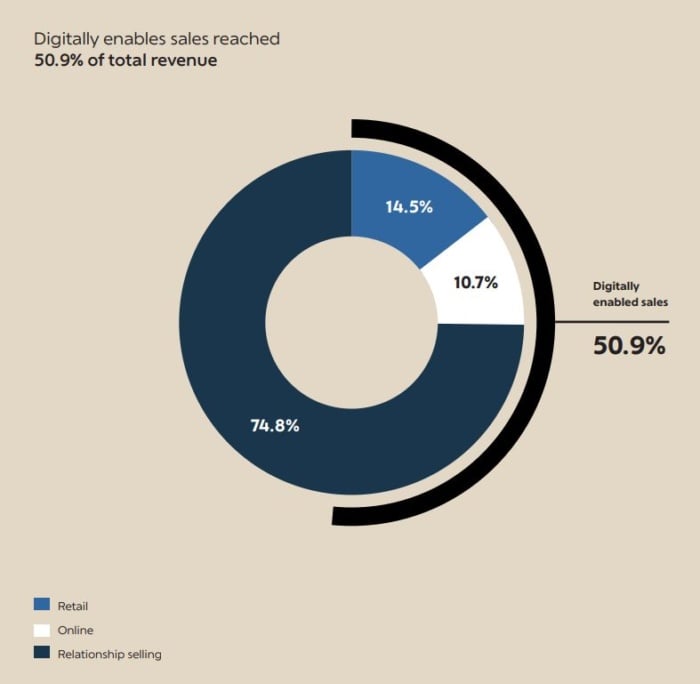
Natura operates in over 100 countries, with almost 8 million consultants and reps, and has products in 3,700 stores and franchises.
Natura also has 45 company-owned stores and products in nearly 4,000 pharmacies.
Distribution Channel FAQs
The more effective and efficient the distribution channels, the more likely customers are to make a purchase.
Additionally, choosing the right distribution channels can help a company target specific types of customers and create a more personalized marketing approach.
For example, if a company wants to reach younger audiences, it can focus on social media and other digital channels. On the other hand, to appeal to an older demographic, traditional marketing channels like print and broadcast media might work better.
Yes, there are different types of distribution channels. When it comes to getting products or services to customers, companies can use a variety of channels such as wholesalers, retail stores, online marketplaces, direct sales, partnerships with other businesses, and more.
The channel choice depends on various factors, including the type of product or service, target audience, and company resources.
Conclusion
Are you ready to define and manage distribution channels for your company?
Follow the steps I mentioned in this article, from benchmarking to sales outlet analysis.
Consider the cost-benefit ratio of each channel, and regardless of your choice, always monitor indicators and metrics.
This analysis makes it possible to check the efficiency of the distribution channel so you can optimize it constantly.
Most importantly, though, ensure you understand your ideal customer so you know where they hang out and where they’re most likely to buy. That’s where distribution channels and marketing channels work together to get the best results.
Which distribution channels do you use? And what are their pros and cons?
Leave a comment with your opinion or any questions you have.

See How My Agency Can Drive More Traffic to Your Website
- SEO - unlock more SEO traffic. See real results.
- Content Marketing - our team creates epic content that will get shared, get links, and attract traffic.
- Paid Media - effective paid strategies with clear ROI.
Are You Using Google Ads?Try Our FREE Ads Grader!
Stop wasting money and unlock the hidden potential of your advertising.
- Discover the power of intentional advertising.
- Reach your ideal target audience.
- Maximize ad spend efficiency.

